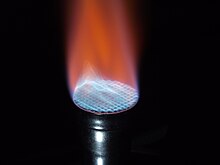Meker–Fisher burner
 A Meker–Fisher burner | |
| Uses |
|
|---|---|
| Inventor | French chemist Georges Méker |
| Related items | |
A Meker–Fisher burner, or Meker burner, is an ambient air laboratory burner that produces multiple open gas flames, used for heating, sterilization, and combustion. It is used when laboratory work requires a hotter flame than attainable using a Bunsen burner, or used when a larger-diameter flame is desired, such as with an inoculation loop or in some glassblowing operations. The burner was introduced by French chemist Georges Méker in an article published in 1905.[1]
The Meker–Fisher burner heat output can be in excess of 12,000 BTU (13,000 kJ) per hour (about 3.5 kW) using LP gas.[2] Flame temperatures of up to 1,100–1,200 °C (2,000–2,200 °F) are achievable. Compared with a Bunsen burner, the lower part of its tube has more openings with larger total cross-section, admitting more air and facilitating better mixing of air and gas. The tube is wider, and its top is covered with a plate mesh, which separates the flame into an array of smaller flames with a common external envelope, ensures uniform heating, and also preventing flashback to the bottom of the tube, which is a risk at high air-to-fuel ratios and limits the maximal rate of air intake in a Bunsen burner. The flame burns without noise, unlike the Bunsen or Teclu burners.[1][3]
See also
[edit]References
[edit]- ^ a b G. Meker. Nouveaux bruleurs de laboratoire et leur application au chauffage a temperature elevee (in French). Journal of Physics: Theories and Applications, 1905, 4 (1), pp. 348–354.
- ^ Durham Geo.
- ^ Hale, Charles W. (1915). Domestic Science. Vol. 2. London: Cambridge University Press. p. 38.
External links
[edit] Media related to Meker-Fisher burners at Wikimedia Commons
Media related to Meker-Fisher burners at Wikimedia Commons- Video of Meker burner in use.
